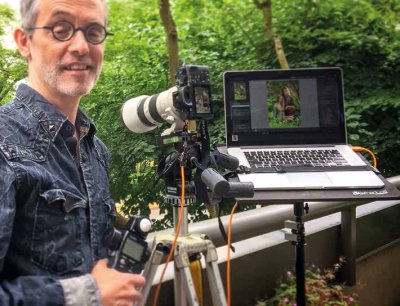articles/Lighting/cwl-page1
Creating With Light - part 1 of 1 2
by Dave Montizambert Published 01/10/2016

Shooting weddings, events, or the like, there is not the luxury of time to really check out and refine each shot you take. But if you are creating images where perfection is more important than speed, then the whole game changes. That is the area of photography I’ve been involved in most of my life, and it has always been a struggle to get to perfection - not that true image perfection is attainable but getting as close as you can before you run out of time, budget and energy. The problem lies in trying to get what you have created to look the way you want on screen or in print. What I create with my lighting is, from a critical standpoint, somewhat different to the digital capture than it is to my eye. I, like all humans, have incredible usable visual dynamic range. So why do I say usable dynamic range? Because our cameras have pretty good dynamic range too, they can see way down into some really dark shadows, but if you try to open up shadows that are too far down on the brightness scale, they start to break apart - posterise - you lose the illusion of continuous tone gradations that your eye so easily sees. All that to say that what you see isn’t exactly what you get; you visually take in this incredible scene with lots of highlight and shadow detail and then are sorely disappointed with the photo that can’t capture all this. So one has to learn to light for the range that the camera can handle.
In the film days I relied almost 100% on incident and reflective meter readings to get the image as close to perfect as I could. Unfortunately trying to visualise your lighting with readings and ratios from a meter isn’t easy, but with practise you can get pretty good at it. For example, when photographing people I usually liked to create a greater sense of depth in the image by having the subject backlit. After doing it a couple of times I found that, in general, I preferred to have this backlighting set to 1.5 stops under the camera exposure. Knowing this ratio was very helpful when setting up, I would consider this ratio in my head, then decide whether the mood I’m trying to portray would be best at this ratio or would it serve better brighter or darker then act accordingly. However, what you see in your mind is never exactly the same as the image. That’s why in the film days I would meter the heck out of the scene/subject, adjust lighting accordingly, and then put a Polaroid back on my view camera or medium-format camera and pull an instant print. Now those Polaroids having less range and contrast didn’t image exactly the same as film, but they did give a tangible version of what was being created.
Really it was just another check to make sure that the lighting ratios you created balance nicely. Polaroids had another important function and that was communication with the art director, designer, and/or client. It was something physical that they could see rather than you trying to put your image into a thousand words. It was the equivalent of an image preview on your camera screen or computer, but nowhere as good.
Shooting Polaroid was an interesting process - when shooting on largeformat view cameras we would first shoot a type 55 Polaroid which was a black and white instant print. The main feature of this print was that it had a negative that we would back-light over a light-table, then hold a highquality loupe (magnifying glass) over it to check for critical focus. With the print portion of this Polaroid, we would back-light it too and this would give a fairly close approximation of the range of contrast that the Kodak Ektachrome transparency (slide) film we typically shot, would record. If all this checked out, then a Type 59 colour Polaroid print which had no usable negative, was exposed for the art director/designer/client so they would have something tangible to use for the sake of complaining about the shot.
My favourite comment that an art director I was working with said after a considerable amount of time agonising over the Type 59 is, 'You know, I can’t find anything wrong with this image! Nothing!' Wow, what a The-Cup-Is-Half-Empty, kind of guy!
You are currently on page 1 Contact Dave Montizambert
1st Published 01/10/2016
last update 09/12/2022 14:53:02
More Lighting Articles
There are 0 days to get ready for The Society of Photographers Convention and Trade Show at The Novotel London West, Hammersmith ...
which starts on Wednesday 15th January 2025





